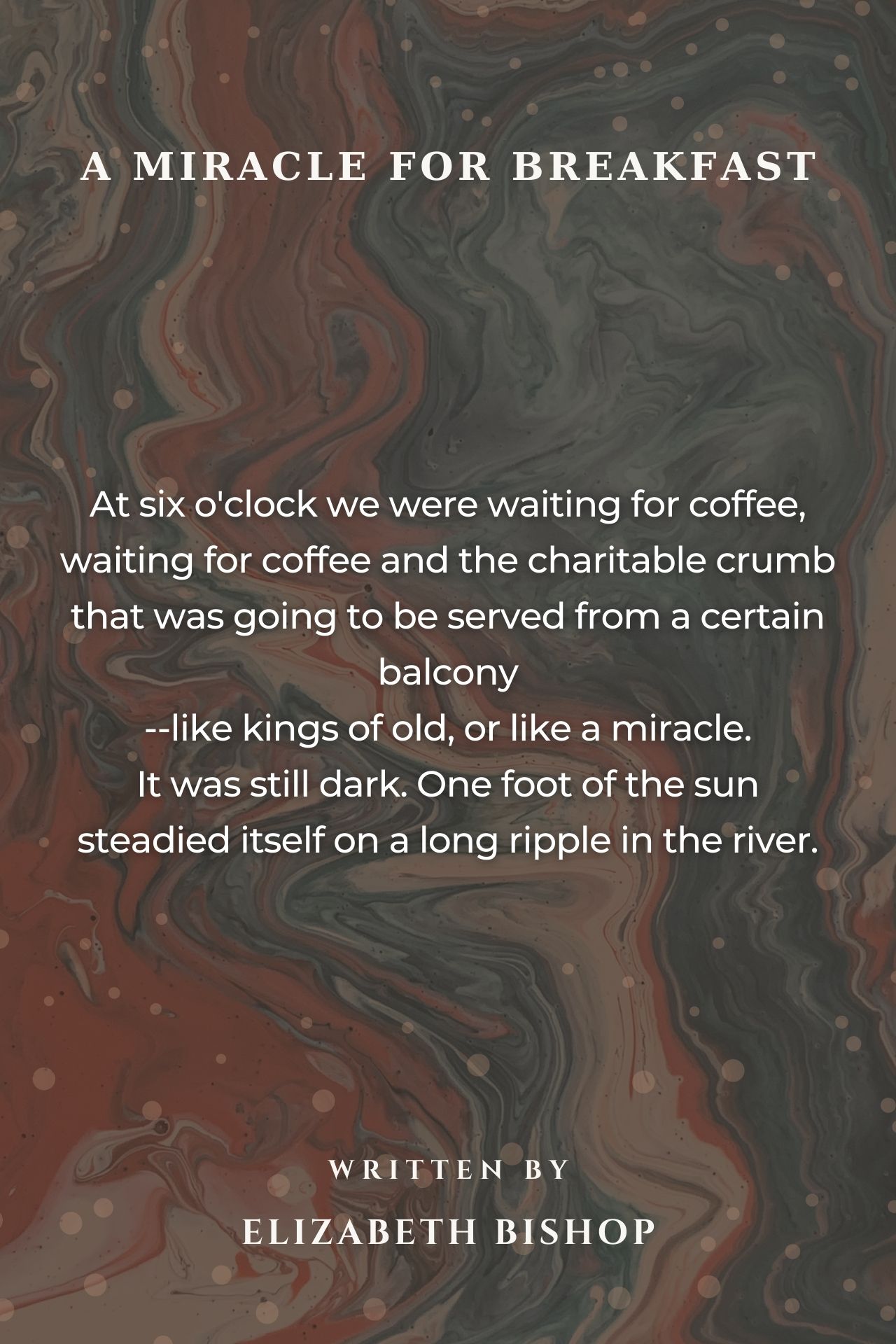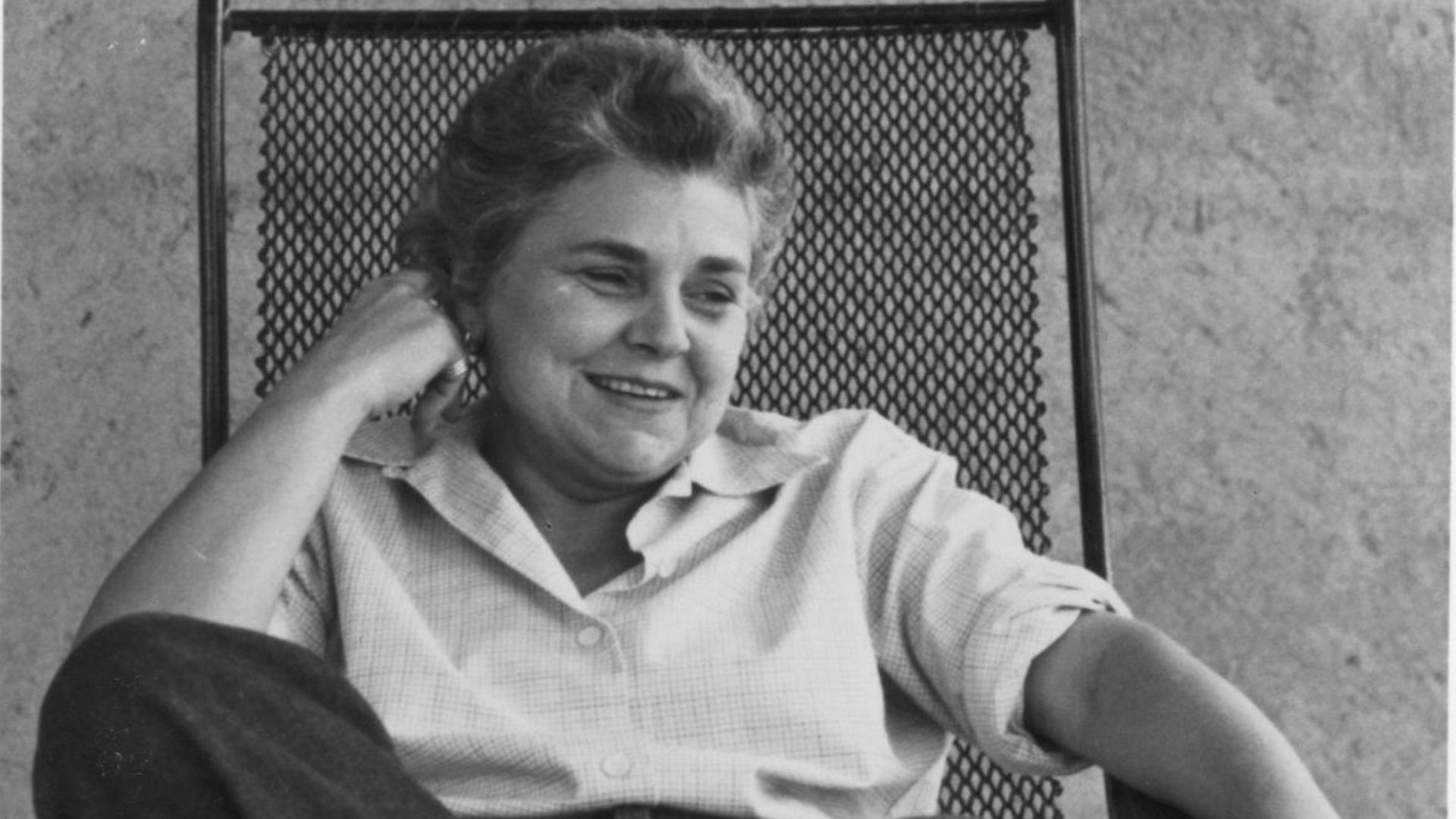A Miracle For Breakfast Poem by Elizabeth Bishop
A Miracle For Breakfast
At six o'clock we were waiting for coffee,
waiting for coffee and the charitable crumb
that was going to be served from a certain balcony
- like kings of old, or like a miracle.
It was still dark. One foot of the sun
steadied itself on a long ripple in the river.
The first ferry of the day had just crossed the river.
It was so cold we hoped that the coffee
would be very hot, seeing that the sun
was not going to warm us; and that the crumb
would be a loaf each, buttered, by a miracle.
At seven a man stepped out on the balcony.
He stood for a minute alone on the balcony
looking over our heads toward the river.
A servant handed him the makings of a miracle,
consisting of one lone cup of coffee
and one roll, which he proceeded to crumb,
his head, so to speak, in the clouds- along with the sun.
Was the man crazy? What under the sun
was he trying to do, up there on his balcony!
Each man received one rather hard crumb,
which some flicked scornfully into the river,
and, in a cup, one drop of the coffee.
Some of us stood around, waiting for the miracle.
I can tell what I saw next; it was not a miracle.
A beautiful villa stood in the sun
and from its doors came the smell of hot coffee.
In front, a baroque white plaster balcony
added by birds, who nest along the river,
- I saw it with one eye close to the crumb-
and galleries and marble chambers. My crumb
my mansion, made for me by a miracle,
through ages, by insects, birds, and the river
working the stone. Every day, in the sun,
at breakfast time I sit on my balcony
with my feet up, and drink gallons of coffee.
We licked up the crumb and swallowed the coffee.
A window across the river caught the sun
as if the miracle were working, on the wrong balcony.

One question: as she was waiting for coffee, watching the man and projecting her thoughts and appreciations upon him, what fate held her unnamed partner? In both the beginning and end of the poem, she makes reference to 'we' - is this another physical partner? Or is she alone with her thoughts, perhaps 'taking herself' to the balcony for breakfast, two partners, body and mind, enjoying crumb and coffee with one another?
He stood for a minute alone on the balcony looking over our heads toward the river. A servant handed him the makings of a miracle, consisting of one lone cup of coffee. a very fine poem. tony
I am not against form but the Sestina is just too contrived. This one, like most leaves me cold.
How does she do it? She sees things we should see- feels things we should feel- but thankfully she writes them into our souls- He stood for a minute alone on the balcony looking over our heads toward the river. A servant handed him the makings of a miracle, consisting of one lone cup of coffee and one roll, which he proceeded to crumb, his head, so to speak, in the clouds- along with the sun.
This poem has not been translated into any other language yet.
I would like to translate this poem
In direct response to Mr. Mumford’s question, I have two items that might be worth mentioning. First, the poem was evidently written during the Great Depression, an era of soup kitchens and long lines of people waiting for hand-outs. So I don’t believe the narrator in the poem had just one companion; she was part of a throng, waiting beneath a balcony. (BTW, the nature of the hoped-for miracle here is very similar to the biblical account of Jesus feeding the 5,000 with seven loaves and a few fish. Mark 8: 1-10.) Secondly, in the fifth and sixth stanzas, Mr. Mumford is absolutely correct: the narrator has retreated into her own imagination, conjuring up a mansion in a bread crumb, where she can “sit on my balcony /with my feet up, and drink gallons of coffee.” However, throughout the remainder of the poem, it seems to me the narrator is firmly planted in reality, stuck if you will in a throng of those victimized by the economy of the 1930s. I find the narration rather frustrating because on the one hand she says her own mansion was “not” a miracle (stanza 5 line 1) and then she affirms that it was indeed a miracle (stanza 6 line 2) . IMHO the ambiguity is unnecessary and perhaps is the source of Mr. Mumford’s initial question. It could certainly be argued that the very existence of imagination is a miracle, and that its skillful use is something to which we all should aspire. (In Ms. Bishop’s defense, it could be that the shift from “not a miracle” to “a miracle” reflects the fact that the narrator’s own mansion is not real.) I would add that the poem has a very ornate, elaborate structure. It is a sestina, a form consisting of six stanzas, each with six lines, and then concluding with a three-line stanza known alternatively as a “tercet, ” “envoi, ” or “tornado.” The same set of six words ends each of the lines of each of the stanzas, but in a different order in each stanza. In this poem, those words are coffee, crumb, balcony, miracle, sun, and river. If we number the first stanza's lines 123456, then the words ending the second stanza's lines should appear in the order 615243, then 364125, then 532614, then 451362, and finally 246531. The same six words then appear in the tercet as well, with the tercet's first line usually containing 1 and 2, its second 3 and 4, and its third 5 and 6.